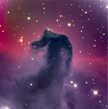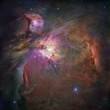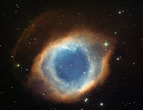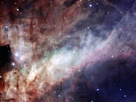Mysterious Clouds
How can there be clouds in space?
There are many different kinds of clouds in space, but none of them have anything to do with what we know as clouds on Earth – which are made out of tiny droplets of water. Originally – before the invention of the telescope – astronomers referred to all the shining, extended structures without clearly defined edges that they saw in space as ‘clouds’ (nebulae in Latin).
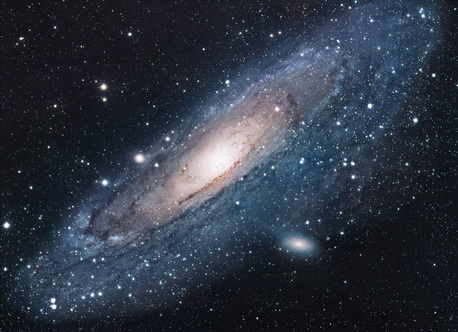 © NASA/Robert Gendler |
The Andromeda Nebula (familiar from science fiction) should really be called the Andromeda Galaxy. Andromeda is a spiral galaxy just like our own galaxy, the Milky Way.
Since even entire galaxies, in other words, large star systems, can appear to be cloudy patches to the naked eye, they were also called ‘nebulae’ – for example, the Andromeda Nebula familiar to us all from science fiction. Often, such star system nebulae were also called extra-galactic nebulae (in other words, outside the Milky Way).
The correct designation for the Andromeda Nebula would be the Andromeda Galaxy because, in modern astronomy, the concept of cloud is used almost exclusively for concentrations of dust and gas found between the stars of a galaxy.
These concentrations of dust and gas emit light due to a variety of mechanisms. Emission nebulae shine because they are excited by the radiation of hot stars to emit light themselves. Reflection nebulae, on the other hand, reflect the light of nearby stars. Dark nebulae, also called dark clouds, are too distant from nearby stars to reflect their light or to be excited to emit light themselves. As dark clouds of gas and cosmic dust, they obstruct the light of stars and other shining nebulae lying behind them, and thus become visible to us. If the matter of a nebula gradually becomes denser, it turns into the birthplace of new stars.
German Aerospace Center
The correct designation for the Andromeda Nebula would be the Andromeda Galaxy because, in modern astronomy, the concept of cloud is used almost exclusively for concentrations of dust and gas found between the stars of a galaxy.
These concentrations of dust and gas emit light due to a variety of mechanisms. Emission nebulae shine because they are excited by the radiation of hot stars to emit light themselves. Reflection nebulae, on the other hand, reflect the light of nearby stars. Dark nebulae, also called dark clouds, are too distant from nearby stars to reflect their light or to be excited to emit light themselves. As dark clouds of gas and cosmic dust, they obstruct the light of stars and other shining nebulae lying behind them, and thus become visible to us. If the matter of a nebula gradually becomes denser, it turns into the birthplace of new stars.
German Aerospace Center
Mysterious Clouds
How can there be clouds in space?
There are many different kinds of clouds in space, but none of them have anything to do with what we know as clouds on Earth – which are made out of tiny droplets of water. Originally – before the invention of the telescope – astronomers referred to all the shining, extended structures without clearly defined edges that they saw in space as ‘clouds’ (nebulae in Latin).
 © NASA/Robert Gendler |
The Andromeda Nebula (familiar from science fiction) should really be called the Andromeda Galaxy. Andromeda is a spiral galaxy just like our own galaxy, the Milky Way.
Since even entire galaxies, in other words, large star systems, can appear to be cloudy patches to the naked eye, they were also called ‘nebulae’ – for example, the Andromeda Nebula familiar to us all from science fiction. Often, such star system nebulae were also called extra-galactic nebulae (in other words, outside the Milky Way).
The correct designation for the Andromeda Nebula would be the Andromeda Galaxy because, in modern astronomy, the concept of cloud is used almost exclusively for concentrations of dust and gas found between the stars of a galaxy.
These concentrations of dust and gas emit light due to a variety of mechanisms. Emission nebulae shine because they are excited by the radiation of hot stars to emit light themselves. Reflection nebulae, on the other hand, reflect the light of nearby stars. Dark nebulae, also called dark clouds, are too distant from nearby stars to reflect their light or to be excited to emit light themselves. As dark clouds of gas and cosmic dust, they obstruct the light of stars and other shining nebulae lying behind them, and thus become visible to us. If the matter of a nebula gradually becomes denser, it turns into the birthplace of new stars.
German Aerospace Center
The correct designation for the Andromeda Nebula would be the Andromeda Galaxy because, in modern astronomy, the concept of cloud is used almost exclusively for concentrations of dust and gas found between the stars of a galaxy.
These concentrations of dust and gas emit light due to a variety of mechanisms. Emission nebulae shine because they are excited by the radiation of hot stars to emit light themselves. Reflection nebulae, on the other hand, reflect the light of nearby stars. Dark nebulae, also called dark clouds, are too distant from nearby stars to reflect their light or to be excited to emit light themselves. As dark clouds of gas and cosmic dust, they obstruct the light of stars and other shining nebulae lying behind them, and thus become visible to us. If the matter of a nebula gradually becomes denser, it turns into the birthplace of new stars.
German Aerospace Center

